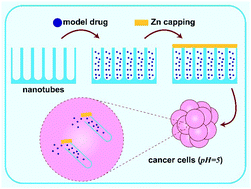Zn capped Al2O3 and TiO2 nanoporous arrays as pH sensitive drug delivery systems: a combined experimental and simulation study†
Abstract
Drug delivery systems sensitive to pH have been investigated recently as a responsive strategy for tumour targeting in view of the slightly acidic pH environment of most solid tumours. Herein, we report Zn capped Al2O3 and TiO2 nanoporous arrays for pH sensitive drug release. The nanostructures were fabricated through electrochemical anodisation. Vitamin C as a model drug was loaded into the nanopores; some were then capped using elemental Zn. The release rates of vitamin C were investigated in water or lactic acid using high performance liquid chromatography (HPLC). The amount of drug loaded into the nanostructures was about 7 times higher for TiO2 compared with Al2O3 and the release was faster from TiO2. Zn capping proved to be quite efficient at preventing release at high pH (7) and not largely hindering the release at low pH (5), making both systems suitable for pH-triggered release. Molecular dynamics (MD) simulations showed that the diffusion of vitamin C molecules through the model nanopores is faster for TiO2 than for Al2O3, consistent with the experimental results. The tremendously stronger H bonding interactions observed for vitamin C molecules and water molecules with the TiO2 walls compared with Al2O3 are responsible for the observed differences in the calculated number density profiles and radial distribution functions.



 Please wait while we load your content...
Please wait while we load your content...